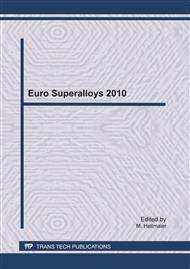p.114
p.120
p.126
p.132
p.138
p.144
p.150
p.156
p.162
Change in Gamma Prime Morphology and Dislocation Substructures of Single Crystal Nickel-Based Superalloy, CMSX-4, Pre-Crept at 1273K-400MPa with Simple Aging
Abstract:
The single crystal nickel-based superalloy, CMSX-4, creep interrupted at the creep strain of 0.01 at 1273K-400MPa was aged at 1273K without stress to make clear the /' rafting mechanism. And the changes in the ' morphology and the dislocation substructures at the /' interface with simple aging time were studied and compared with the previous work at 1273K-250MPa. The cuboidal ' precipitates were regularly arrayed when the creep test was interrupted, but changed to the rafted /' structures normal to the pre-creep stress axis with simple aging time. The aspect ratio of the ' precipitates increased with increasing simple aging time up to 3.60x106s, attained to the maximum value and then decreased. The maximum value of the aspect ratio at 400MPa was lower than one at 250MPa. A number of dislocations were tangled with each other at the /' interfaces of the creep interrupted specimen. These tangled dislocations were only rearranged by simple aging and the dislocation density at the /' interfaces was almost constant, independent of simple aging time. All dislocations of the creep interrupted specimen at the /' interfaces with six kinds of the <110> Burgers vectors were detected equally. The proportion of the six kinds of the <110> Burgers vectors didn’t change with simple aging time. Consequently, dislocations at the /' interfaces were considered as not the misfit ones, but the traces of mobile dislocations in the channels and the formation of the rafted /' structures might be closely correlated with the rearrangement of tangled dislocations at the /' interfaces.
Info:
Periodical:
Pages:
138-143
Citation:
Online since:
July 2011
Keywords:
Permissions:
Share:
Citation:


